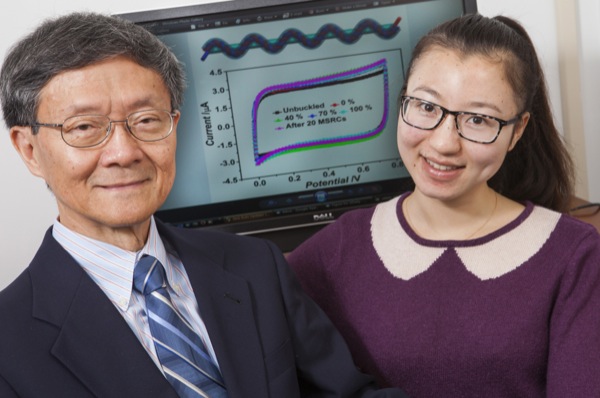
Stretchable energy sources
UD researchers develop stretchable wire-shaped supercapacitor
11 a.m., Nov. 1, 2013--Advances in flexible and stretchable electronics have prompted researchers to explore ways to create stretchable supercapacitors — robust energy storage devices — to power these and other devices.
Supercapacitors offer significant advantages over common batteries, including the ability to recharge in seconds, exceptionally long life span and high reliability, leading to their incorporation in portable consumer electronics, memory backup devices, hybrid vehicles and even large industrial scale power and energy management systems.
Research Stories
Chronic wounds
Prof. Heck's legacy
Wire-shaped supercapacitors, in particular, have attracted attention for uses in wearable energy devices.
University of Delaware professors Tsu-Wei Chou and Bingqing Wei have successfully developed a compact, stretchable wire-shaped supercapacitor (WSS) based on continuous carbon nanotube (CNT) fibers.
Chou, Pierre S. du Pont Chair of Engineering, is an internationally-known composites expert who specializes in using carbon nanotube fibers for multifunctional composites and energy storage devices. Wei, professor of mechanical engineering, has expertise in creating scalable power sources for stretchable electronics.
They used a prestraining-then-buckling approach to fabricate the wire-shaped supercapacitor using a Spandex fiber as the substrate, a polyvinyl alcohol-sulfuric acid gel as the solid electrolyte, and carbon nanotube (CNT) fibers as the active electrodes.
When subjected to a tensile strain of 100 percent over 10,000 charge/discharge cycles, the CNT supercapacitor’s electrochemical performance improved to 108 percent, revealing its excellent electrochemical stability.
Wei, who credits the supercapacitor’s performance to the intrinsic mechanical and physical properties of the flexible CNT fibers, said, “The network of individual CNTs and their bundles endow the fibers with the capacity to withstand large deformation without sacrificing mechanical properties, electrical conductivity, and electrochemical properties.”
“This unique combination of outstanding electrochemical performance and stretchability may enable the integration of wire-shaped supercapacitors with wearable, miniaturized and portable electronic devices,” said Chou.
The professors recently published their findings in Advanced Energy Materials. The first author on the paper was Ping Xu, a visiting student from Donghua University in Shanghai, China.
Article by Karen B. Roberts
Photo by Ambre Alexander








